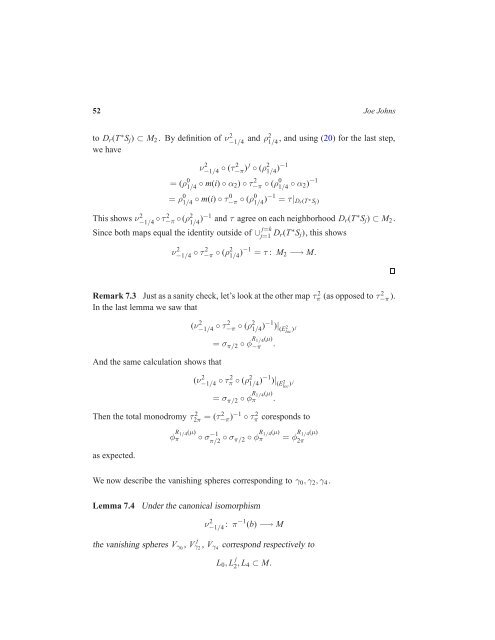The Picard-Lefschetz theory of complexified Morse functions 1 ...
The Picard-Lefschetz theory of complexified Morse functions 1 ...
The Picard-Lefschetz theory of complexified Morse functions 1 ...
You also want an ePaper? Increase the reach of your titles
YUMPU automatically turns print PDFs into web optimized ePapers that Google loves.
52 Joe Johns<br />
to Dr(T ∗Sj) ⊂ M2. By definition <strong>of</strong> ν2 −1/4 and ρ2 1/4 , and using (20) for the last step,<br />
we have<br />
ν 2 −1/4 ◦ (τ 2 −π ) j ◦ (ρ 2 1/4 )−1<br />
= (ρ 0 1/4 ◦ m(i) ◦ α2) ◦ τ 2 −π ◦ (ρ 0 1/4<br />
◦ α2) −1<br />
= ρ 0 1/4 ◦ m(i) ◦ τ 0 −π ◦ (ρ0 1/4 )−1 = τ|Dr(T ∗ Sj)<br />
This shows ν 2 −1/4 ◦τ 2 −π ◦ (ρ2 1/4 )−1 and τ agree on each neighborhood Dr(T ∗ Sj) ⊂ M2.<br />
Since both maps equal the identity outside <strong>of</strong> ∪ j=k<br />
j=1 Dr(T ∗ Sj), this shows<br />
ν 2 −1/4 ◦ τ 2 −π ◦ (ρ2 1/4 )−1 = τ : M2 −→ M.<br />
Remark 7.3 Just as a sanity check, let’s look at the other map τ 2 π (as opposed to τ 2 −π ).<br />
In the last lemma we saw that<br />
And the same calculation shows that<br />
(ν 2 −1/4 ◦ τ 2 −π ◦ (ρ2 1/4 )−1 )| (E 2 loc ) j<br />
= σπ/2 ◦ φ R1/4(µ) −π .<br />
(ν 2 −1/4 ◦ τ 2 π ◦ (ρ2 1/4 )−1 )| (E 2 loc ) j<br />
= σπ/2 ◦ φ R1/4(µ) π .<br />
<strong>The</strong>n the total monodromy τ 2 2π = (τ 2 −π )−1 ◦ τ 2 π<br />
as expected.<br />
φ R 1/4(µ)<br />
π<br />
coresponds to<br />
◦ σ −1<br />
π/2 ◦ σπ/2 ◦ φ R1/4(µ) π = φ R1/4(µ) 2π<br />
We now describe the vanishing spheres corresponding to γ0,γ2,γ4 .<br />
Lemma 7.4 Under the canonical isomorphism<br />
ν 2 −1/4 : π−1 (b) −→ M<br />
j<br />
the vanishing spheres Vγ0 , Vγ2 , Vγ4 correspond respectively to<br />
L0, L j<br />
2 , L4 ⊂ M.
















